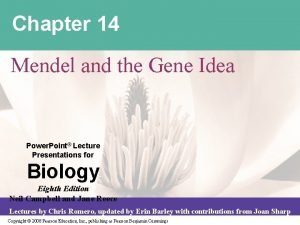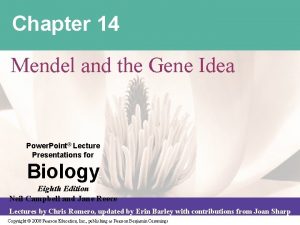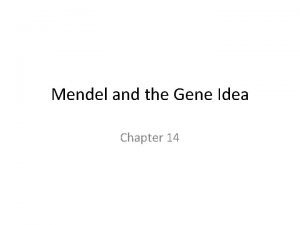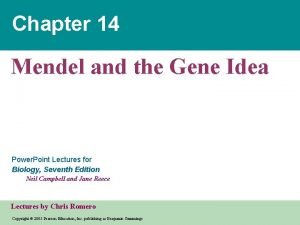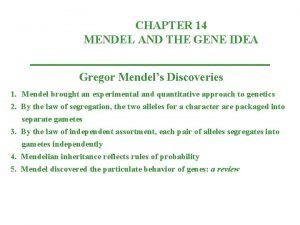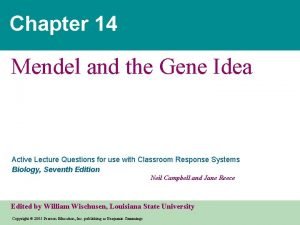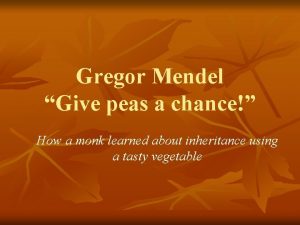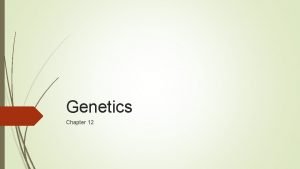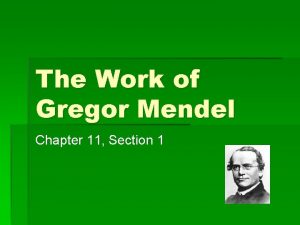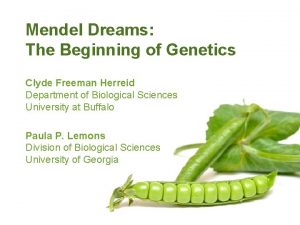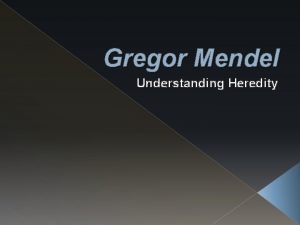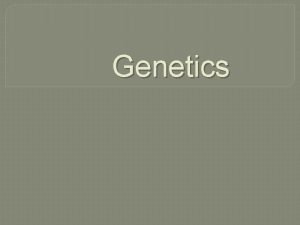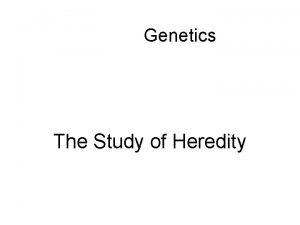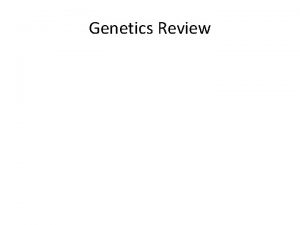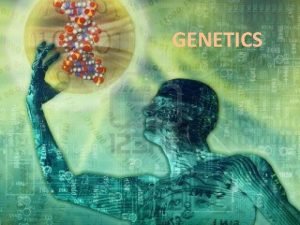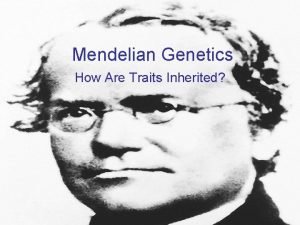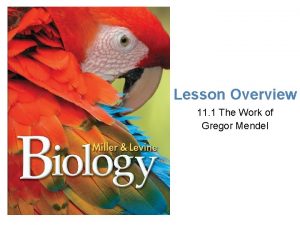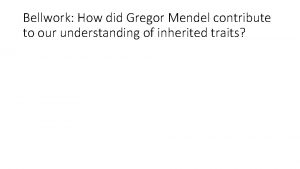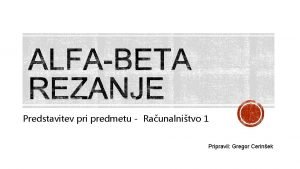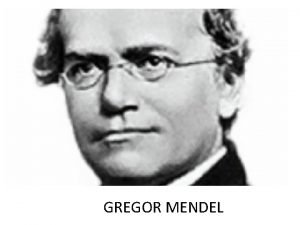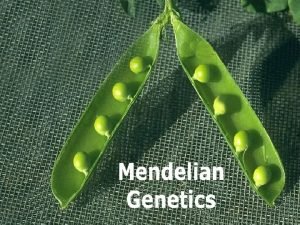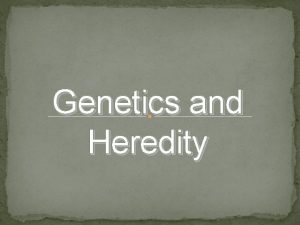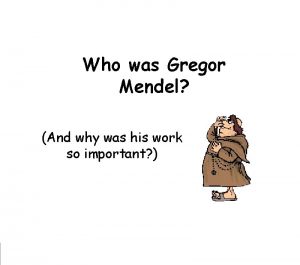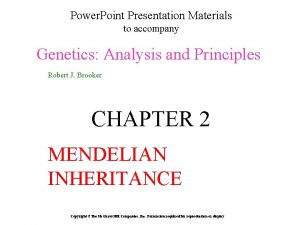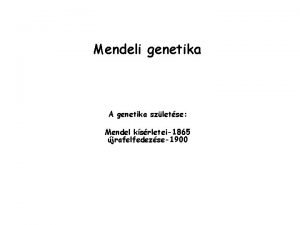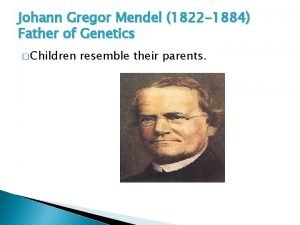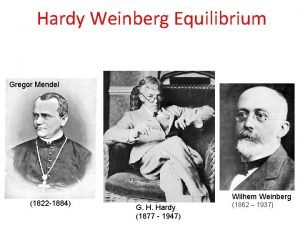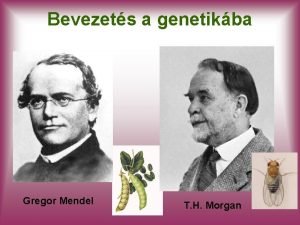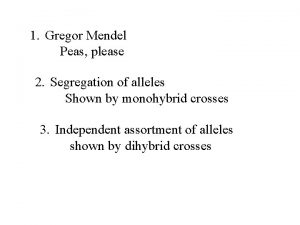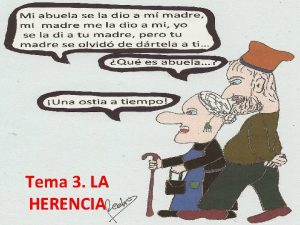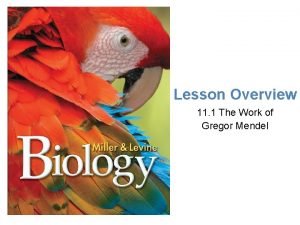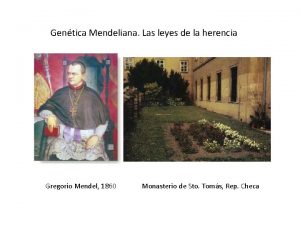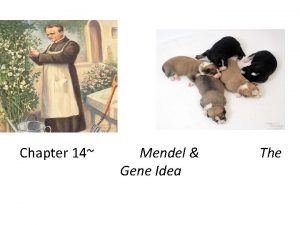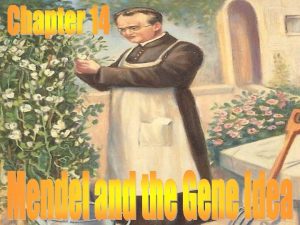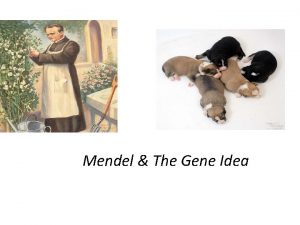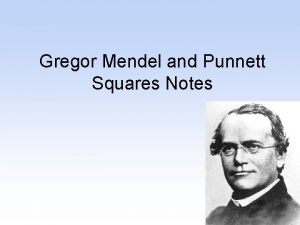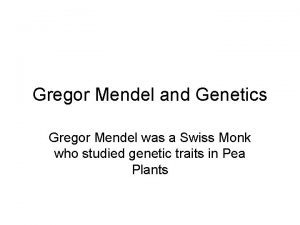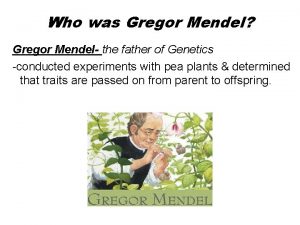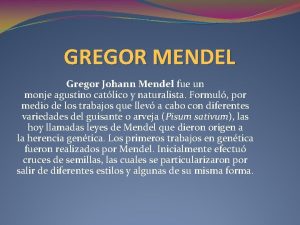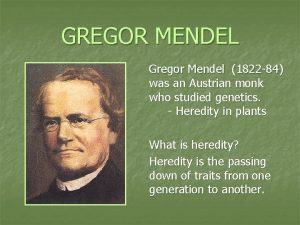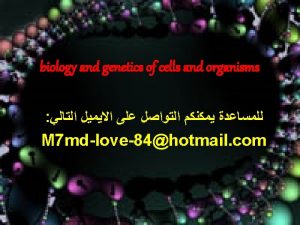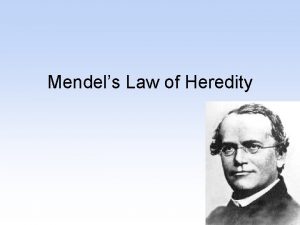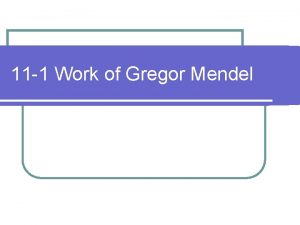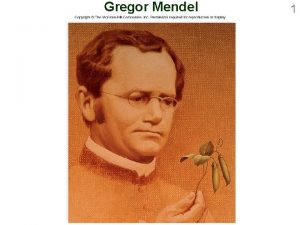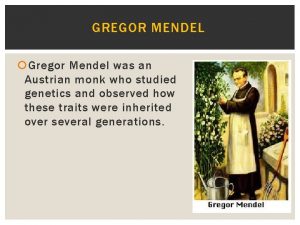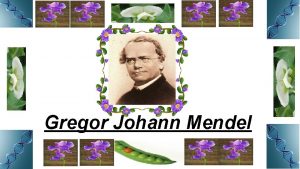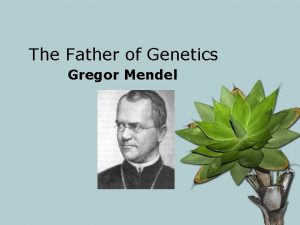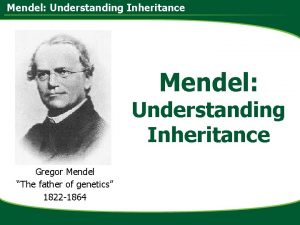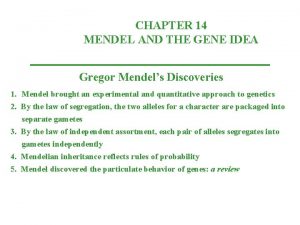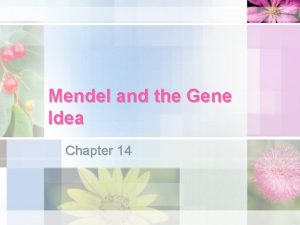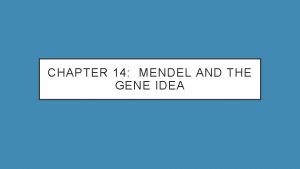Chapter 11 Mendel and the Gene Idea Gregor























![Genotype Probabilities Aa. Bb. Cc. Dd. Ee x AABb. Cc. DDEc p[A] = 0. Genotype Probabilities Aa. Bb. Cc. Dd. Ee x AABb. Cc. DDEc p[A] = 0.](https://slidetodoc.com/presentation_image/a0b9bca0efdef2c5c9a03fe713bb502a/image-24.jpg)

























- Slides: 49

Chapter 11: Mendel and the Gene Idea

Gregor Mendel FATHER OF GENETICS 1) 2) 3) BECAME A PRIEST LIVED WITH PARENTS AND GREW PEA PLANTS STUDIED SCIENCE AND MATH 4) AT UNIV. OF VIENNA IN AUSTRIA 5) 6) Used 4) STUDIED PASSING OF TRAITS FROM PARENT TO OFFSPRING ( HEREDITY) OF 7 TRAITS IN PEA PLANTS pea plants because: 1) Easy access 2) 2) easy fertilization

Mendelian Theory • 1) Took true breeding plants (P 1) and cross pollinated for one trait (monohybrid) and look at each generations ( F 1 and F 2) results • 2) For all 7 traits studied all ratios were the same • **when 2 F 1 was self pollinated result was always 3: 1 (dominant: recessive) • • 3) 2 laws were established: • a) Law of Segregation—pg 176 • b) Law of Independent Assortment-pg 181

Alleles and Loci An allele is a variation of a gene Locus-- Gene location on chromosome A gene is a heritable unit that comes in

Terms • Allele • Geneotype • pheotype

True Breeding True breeding results when both parents are homozygous for the same trait,

Crossing Peas Cross pollination – transfer pollen of one flower (sperm) to the carpel of another flower (egg)

First Generation Offspring First filial generation

Pea Characters & Traits Note difference between “character” and “trait”

More Pea Characters & Traits A trait is a variant of a character The interaction between non-identical alleles results in interesting noncorrespondences between genotype and phenotype Note 3: 1 ratios

Even more…

Monohybrid Cross Dominant phenotype Recessive phenotype Heterozygote Genotype unknown (homo- vs. heterozygote)

Monohybrid Cross = monohybrid

Monohybrid Cross Homozygous dominant Heterozygote Homozygous recessive = monohybrid

Genotype vs. Phenotype Dominant phenotype Recessive phenotype

Contrasting Genotype & Phenotype Genotype • DNA nucleotide sequence • Gene, Allele • Chromosomes • Diploidy, Haploidy • Homozygous • Heterozygous Phenotype • What an organisms “looks like” • Character, Trait • Dominant, Recessive • Incomplete Dominance • Complete Dominance • 3: 1 & 9: 3: 3: 1 ratios • Law of Segregation • Law of Independent Assortment • Multiple Alleles • Polygenic Inheritance • • • Codominance Pleiotropy, Epistatsis Quantitative Characters Norm of Reaction Nature vs. Nuture

Following Genotype Segregation of alleles occurs here 3: 1 ratios… Punnett square Example of complete dominance, a. k. a. , dominance

Test Cross 1 phenotype, 2 possible genotypes Blank “slate” Homozygous recessive

Dihybrid Cross (2 loci, 2 alleles) q 9: 3: 3: 1 ratio that is dependent on: • • Two loci, two alleles per locus Independent assortment between loci (genotypic independence) Dominance-recessive relationships between the alleles found at each locus One locus does not affect the phenotype of the other locus (phenotypic independence) 3: 1 ratios are all over this

Segregation of Alleles

Dihybrid Cross Dihybrids

Many Loci, Many Alleles = trihybrids

Probability Theory 1. Statistical Independence 2. Range of Probabilities (0. . 1) 3. Law of Multiplication 4. Calculation for Events not Happening 5. The Law of Addition
![Genotype Probabilities Aa Bb Cc Dd Ee x AABb Cc DDEc pA 0 Genotype Probabilities Aa. Bb. Cc. Dd. Ee x AABb. Cc. DDEc p[A] = 0.](https://slidetodoc.com/presentation_image/a0b9bca0efdef2c5c9a03fe713bb502a/image-24.jpg)
Genotype Probabilities Aa. Bb. Cc. Dd. Ee x AABb. Cc. DDEc p[A] = 0. 5 p[AX] = 0. 5 + 0. 5 = 1. 0 p[A] = 0. 0 p[a] = 0. 5 X p[A] = 0. 5 p[Aa] = 0. 5 x 1. 0 = 0. 5 p[Xa] = 0. 0 + 0. 5 = 0. 5 What Fraction Aa. Bb. Cc. Dc. Ee?

Incomplete Dominance Note 1: 1 correspondence between genotype & phenotype!

Codominance q In codominance the phenotype consists of the phenotypes normally associated with both alleles, i. e. , not a watered down version of one (as one sees with incomplete dominance) q Generally, at the molecular level & to the extent that proteins are made at all, most alleles are codominant q In the heterozygote more than one type of protein product is produced per locus per chromosome q Aa and AA (actually Ia & IA) have different molecular phenotypes even if A is dominant to a at the organismal level q Example is ABO blood group where A and B are codominant to each other (whereas both A and B are fully dominant to O) q Note (again) 1: 1 correspondence between genotype & phenotype

Molecular Codominance Note codominant at molecular level

Multiple alleles MULTIPLE ALLELES– when one gene has several possible alleles for its gene ; more than 2 phenotypes result!!!!!

Pleitropy PLEIOTROPY--- a gene affects more than one characteristic of an individual q This is a common feature of human (etc. ) genes • Marfan syndrome: Affects the eye, the skeleton ( tall , thin, long arms ) and the cardiovascular system • ? Ab Lincoln q What all of the this means is that individual genes typically are active within numerous tissues, and that a character often may be modified via different pathways and routes

Pleitropy

EPISTASIS– genes at 2 loci interact to control a single trait Epistasis Ex: Albino --- pathway for synthesis of melanin; any defect in production results in no melanin production B b Bx bb Black brown Note not 9: 3: 3: 1 ratios C Co lor c colorless Cx Co lor cc colorless Lack of phenotypic independence between loci!

Polygenic Inheritance Many loci, quantitatively contributing to single continuously varying character, e. g. , hair color or height

“Nature” vs. “Nurture” q Nature = Genetics (Genotype) q Nurture = the Environment q Phenotype = Genotype + Environment q Ex; temperature vs color fur on rabbit q. Siamese cats fur

Phenotype Norms of Reaction Genotype 1 Genotype 2 Environment q Reaction norms: Trait varies with environment q Reaction norms are quantitative measures of how genotypes respond, phenotypically, to environments

AUTOSOMES VS SEX CHROMOSOMES • AUTOSOME--- 1 ST 22 PAIRS OF CHROMSOMES • Sex -- 23 RD PAIR; some characteristics ( protein production genes are inherited on the X chromosomes) • ex: blood clotting factor;

Pedigree Analysis

Human Traits Dominant Trait Widow’s peak Freckles Free earlobe Normal Normal hearing Huntington’s Disease Dwarfism Recessive Trait Straight hairline No freckles Attached earlobe Cystic fibrosis Phenylketonuria Tay-Sachs disease Albinism Inherited deafness Normal height Table is from http: //207. 233. 44. 253/wms/reynolmj/lifesciences/lecturenote/bio 3/Chap 09. ppt q Most genetic diseases are recessive traits q In other words, there is an absence of a protein function

Dominant vs. Recessive Autosomal dominant Autosomal recessive Males and females affected? Yes Males and females transmit the trait? Yes Trait skips generations? No Yes At least one parent of affected child must be affected? Yes No Note that lethal dominant traits tend to be very rare because affected individuals tend to die before mating

Autosomal Dominant Inheritance Generations are not skipped No silent carriers Typically about half the offspring are affected, but don’t count on this!!!

Autosomal Dominant Inheritance Generations are not skipped

Autosomal Dominant Inheritance Generations are not skipped Huntington’s disease

Pedigree Analysis (dominant)

Autosomal Recessive Inheritance q Heterozygotes carry the recessive allele but exhibit the wildtype phenotype q Males and females are equally affected and may transmit the trait q May skip generations q Note that with rare recessive traits we usually assume that people from outside of a family do not possess the affecting allele

Autosomal Recessive Inheritance Generation skipped

Autosomal Recessive Inheritance Often both parents are silent carriers Sickle-cell disease Cystic Fibrosis Generations skipped Typical is 1/4 th affected

Consanguineous Mating Inbreeding unmasks otherwise rare recessive traits because genotypes of parents are not independent Consanguineous mating (=) “With blood”

Autosomal Recessive Inheritance Generations skipped More likely early onset lethal than if dominant

Pedigree Analysis (recessive) Generation skipped

The End
 Mendel and the gene idea chapter 14
Mendel and the gene idea chapter 14 Chapter 14 mendel and the gene idea
Chapter 14 mendel and the gene idea Chapter 14 mendel and the gene idea
Chapter 14 mendel and the gene idea Chapter 14 mendel and the gene idea
Chapter 14 mendel and the gene idea Chapter 14 mendel and the gene idea
Chapter 14 mendel and the gene idea Chapter 14 mendel and the gene idea
Chapter 14 mendel and the gene idea Chapter 12 lesson 1 the work of gregor mendel
Chapter 12 lesson 1 the work of gregor mendel Chapter 12 lesson 1 the work of gregor mendel
Chapter 12 lesson 1 the work of gregor mendel Chapter 11 the work of gregor mendel
Chapter 11 the work of gregor mendel Who is gregor mendel and what is he famous for
Who is gregor mendel and what is he famous for Who is gregor mendel and what did he do?
Who is gregor mendel and what did he do? Section 11-1 the work of gregor mendel
Section 11-1 the work of gregor mendel Austrian genetic traits
Austrian genetic traits Father of genetics
Father of genetics Rryy x rryy punnett square
Rryy x rryy punnett square Gregor mendel chart
Gregor mendel chart Incomplete dominance
Incomplete dominance What did gregor mendel research
What did gregor mendel research What did gregor mendel do
What did gregor mendel do How many pairs of chromosomes do humans have? *
How many pairs of chromosomes do humans have? * Gregor mendel conclusions
Gregor mendel conclusions Gregor mendel’s principles of genetics apply to
Gregor mendel’s principles of genetics apply to Tt x tt punnett square
Tt x tt punnett square Gregor mendel plant
Gregor mendel plant Gregor mendel
Gregor mendel Gregor mendel summary
Gregor mendel summary Js bach lebenslauf
Js bach lebenslauf Law of independent assortment vs law of segregation
Law of independent assortment vs law of segregation How did gregor mendel contribute to genetics
How did gregor mendel contribute to genetics Gregor mendel referat
Gregor mendel referat Gregor mendel
Gregor mendel Blank is the austrian monk who experimented with blank
Blank is the austrian monk who experimented with blank Mendel traits
Mendel traits Gregor mendel laws
Gregor mendel laws Gregor mendel laws
Gregor mendel laws Tesztelő keresztezés
Tesztelő keresztezés Al cruzar una planta de guisantes de flores purpura
Al cruzar una planta de guisantes de flores purpura Gregor mendel
Gregor mendel Mendel
Mendel Gregor mendel austrian monk
Gregor mendel austrian monk Gregor mendel
Gregor mendel Mendel genetics
Mendel genetics Fr gregor mendel
Fr gregor mendel Gregor mendel
Gregor mendel Alelo
Alelo Gregor mendel
Gregor mendel Gregor johann mendel
Gregor johann mendel Gregor mendel
Gregor mendel Gregor mendel herencia
Gregor mendel herencia Gregor mendel mbti
Gregor mendel mbti
